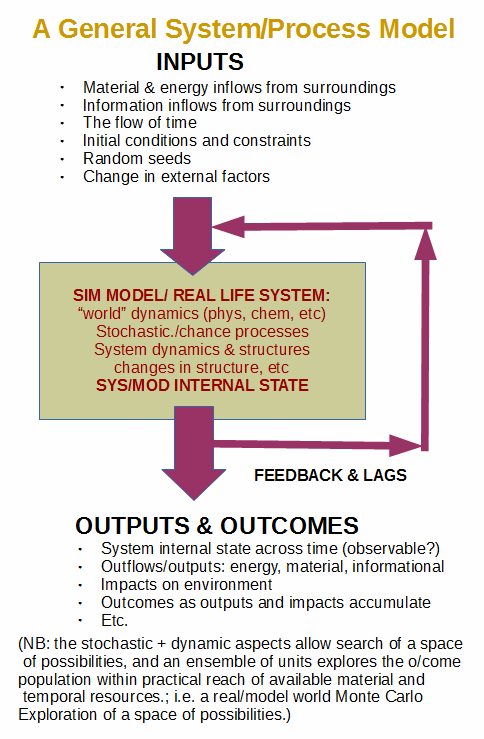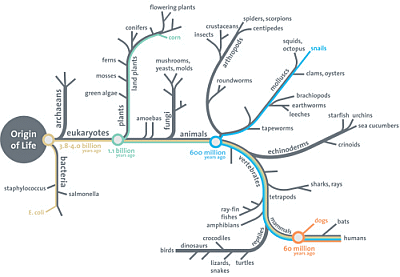. . . and blatant denial is not an appropriate response to the reality of and/or easily known facts concerning functionally specific complex organisation and /or associated information, FSCO/I:
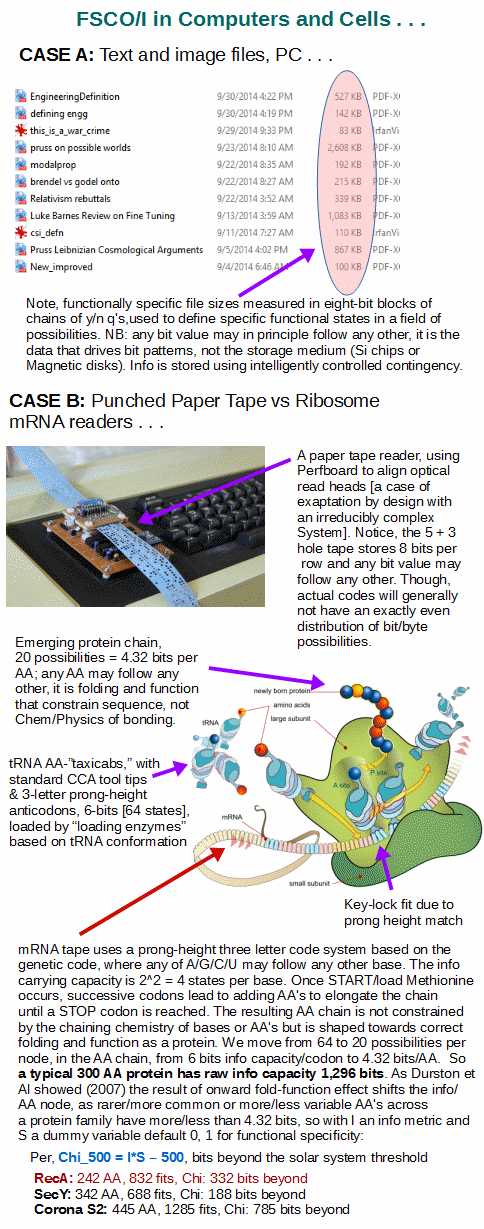 Facts are stubborn things, but people can be more stubborn than that.
Facts are stubborn things, but people can be more stubborn than that.
(That is, there are two types of ignorance,
I: simple ignorance because one does not know the facts and/or may not understand them, but also
II: ideological closed-mindedness due to being controlled by mind-closing agendas hostile to, selectively hyperskeptical towards and dismissive or suppressive of inconvenient facts,
. . . such as those we just saw regarding FSCO/I.)
Why am I saying this?
Poster-boy no 1, rich @ 252 in the UD no bomb thread:
[KF:] “Your comment no 248 to me is 1071 characters, at 7 bits each, wel past the 500 bit threshold.”
[rich:] very good – now you need to show how many comments could have performed the same function across multiple langues,uses of syntax, abbreviations, different audiences, etc.
And Writing messages is (mainly) spontaneous generation, which is NOTHING AT ALL LIKE LIFE.
But….but…but…BIG NUMBERS!
Rich again, at no 400 (and repeatedly thereafter),
. . . on the folly of FCSIO (and how it differs from CSI) as ‘exemplified by the internet’
*You model spontaneous generation (of text)
*You don’t account for functionally equivalent variants
*You can’t specify in anything other than English
*You wont take up design challenges
*Non of this has anything to do with life
*But..but..but..BIG NUMBERS.
“Big numbers” of course, is a dismissive way of ducking the unmet challenge of blind chance and mechanical necessity finding islands of function constrained by the need for having many well matched, correctly arranged components to achieve function. Such as:
a: the node-arcs Wicken wiring diagram network of say an ABU Cardinal . . . Swedish made! (so much for English only, please) . . . fishing reel (reducible to a structured set of y/n q’s, as is commonly done using say AutoCAD etc);
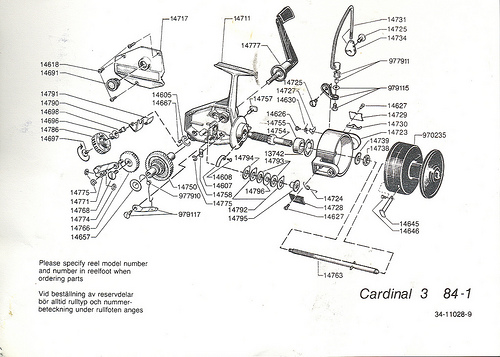
b: a functional . . . Russian I believe . . . mechanical watch (as opposed to a jumbled pile of parts):

c: sand castles (vs dirt piles, including say those built by volcanoes):

d: Lego brick castles (as opposed to haphazard piles of said bricks):
e: Brilliant cut diamonds (as opposed to diamonds in the rough):
f: And of course, the protein synthesis mechanism that is in every living cell of every biological organism, which uses the genetic code (a case of machine code) and associated algorithms plus correctly arranged execution machines:

In each of these cases, we have multiple, well matched components that must be correctly organised and coupled together to effect the requisite function.
A text string is just a special case of such a nodes-arcs wiring diagram network, a string -*-*-*-*- like pearls on a necklace. As AutoCAD etc and the exploded view of the Abu Cardinal reel above show, the general 3-D form of such a wiring diagram can be reduced to a string of structured Y/N . . . one bit info capacity . . . questions and stored as strings. So, the string case is WLOG, without loss of generality (as has been repeatedly pointed out but willfully ignored in order to sneer at text string cases).
As for the strawman tactic assertion of failing to address functionally equivalent variants, all along, the discussion has pivoted on the concept of a sea of possible configurations that has in it islands of function, which may well have peaks and valleys of better or lesser effectiveness, or variations that carry out the same specific functionality. Thus, the point of the case E from zone T in wider space W (standing in for Omega . . . hint, hint as in s = k log w etc) in this infographic which has been used quite a few times in recent months (and the underlying remarks by WmAD in his NFL as cited, and the 100+ year old concept of clusters of microstates or configs studied in statistical thermodynamics that lies aback the simple metaphor “islands of function”):
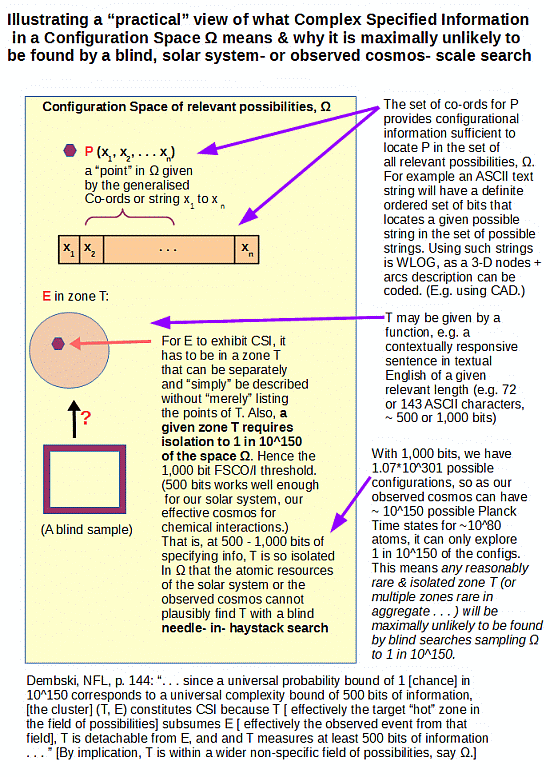 In such a situation, the paradigm case is OOL, where at best we start with some fairly simple chemicals in a Darwin warm salt-laden pond or a comet core or a gas giant moon (to get a reducing atmosphere) etc. These start with molecules scattered across the pond etc, that need to assemble in ways that yield a complex, gated, metabolising cell with a protein assembly mechanism and an additional von Neumann kinematic self replicating facility with coded tape/blueprint for the requisite components plus appropriate co-ordination and algorithms.
In such a situation, the paradigm case is OOL, where at best we start with some fairly simple chemicals in a Darwin warm salt-laden pond or a comet core or a gas giant moon (to get a reducing atmosphere) etc. These start with molecules scattered across the pond etc, that need to assemble in ways that yield a complex, gated, metabolising cell with a protein assembly mechanism and an additional von Neumann kinematic self replicating facility with coded tape/blueprint for the requisite components plus appropriate co-ordination and algorithms.
U/D, Oct 28: here is the challenge such has to meet at OOL:
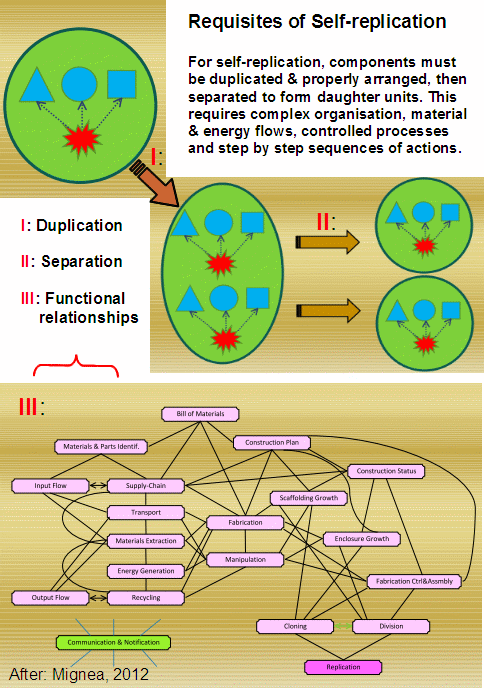
. . . with a general model for studying how systems can explore/ “search” configurational possibility spaces and interact with the external world:
. . . and, all along the tree of life, courtesy Smithsonian (note its root, OOL):
That is, after all, the main phenomenon to be explained per evolutionary materialism on blind chance plus mechanical necessity on the gamut of the observed cosmos: the living cell.
Many diverse cells are possible, but all of them depend crucially on embedded FSCO/I. (Where, of course, on trillions of cases in point — start with the Internet and move on to screws, bolts and nuts etc . . . — there is but one empirically known, needle in haystack analysis reliable source for FSCO/I under such circumstances, intelligently directed configuration, aka design. Thus there is an inductively strong case for inferring design as best warranted causal explanation from FSCO/I as reliable sign.)
Where, too, it is appropriate to note the following exchange between Orgel and Shapiro on the major evolutionary materialistic schools of thought on OOL:
Unfortunately, neither chemists nor laboratories were present on the early Earth to produce RNA . . .
Mutual ruin, in a nutshell.
Mutual ruin, on precisely the challenge of origin of the FSCO/I in the cell in its genes and its interlocking , astonishingly complex metabolic processes that dwarf the FSCO/I in say a petroleum refinery . . . while being carried out in a tiny automaton smaller than the head of a pin:

Indeed, it is worth letting Denton’s classic comment of 1985 speak with full force:
As for the assertion that I and others will not take up and respond to challenges to design as cause of FSCO/I, the very examples of the lego pile, the sand castle and the brilliant cut diamond give the lie to such bare faced false accusations, as well as dozens of other cases over the years. (Look, mon, I had a very senior Govt officer on the phone to me already for the morning and have had to do other things also; please have the reasonableness to take me at my word when I say real life has to take priority. You owe us an apology. Not that we are holding our collective breath.)
As for the brazen assertion that none of this has anything to do with cell based life, let the OOL researchers Orgel and Wicken answer from the 1970’s.
ORGEL, 1973:
. . . In brief, living organisms are distinguished by their specified complexity. Crystals are usually taken as the prototypes of simple well-specified structures, because they consist of a very large number of identical molecules packed together in a uniform way. Lumps of granite or random mixtures of polymers are examples of structures that are complex but not specified. The crystals fail to qualify as living because they lack complexity; the mixtures of polymers fail to qualify because they lack specificity. [The Origins of Life (John Wiley, 1973), p. 189.]
WICKEN, 1979:
Backed up by Nobel equivalent prize holder, Sir Fred Hoyle, at the turn of the ’80’s:
Once we see that life is cosmic it is sensible to suppose that intelligence is cosmic. Now problems of order, such as the sequences of amino acids in the chains which constitute the enzymes and other proteins, are precisely the problems that become easy once a directed intelligence enters the picture, as was recognised long ago by James Clerk Maxwell in his invention of what is known in physics as the Maxwell demon. The difference between an intelligent ordering, whether of words, fruit boxes, amino acids, or the Rubik cube, and merely random shufflings can be fantastically large, even as large as a number that would fill the whole volume of Shakespeare’s plays with its zeros. So if one proceeds directly and straightforwardly in this matter, without being deflected by a fear of incurring the wrath of scientific opinion, one arrives at the conclusion that biomaterials with their amazing measure or order must be the outcome of intelligent design. No other possibility I have been able to think of in pondering this issue over quite a long time seems to me to have anything like as high a possibility of being true.” [[Evolution from Space (The Omni Lecture[ –> Jan 12th 1982]), Enslow Publishers, 1982, pg. 28.]
I suggest to you that the above three cites give the root of the descriptive terms specified complexity, complex specified information, functionally specific complex organisation and information, and intelligent design. Where INTELLIGENT is needed to stress what is meant by design given the way language tends to get twisted into pretzels in recent decades.
Rich’s selectively hyperskeptical quarrel is not with me or us, but with the highly informed views of quite significant researchers, as well as just plain ordinary readily evident but apparently ideologically inconvenient facts.
______
Okay, that should be enough to highlight that FSCO/I — actually, a commonplace phenomenon, as familiar as the files on your computer, and as routinely quantifiable as the file sizes you see routinely reported by your operating system or the genetic info in the codes for a protein — is not a dubious and ill-conceived concept fraudulently foisted on the world by “IDiots” who are “Creationists in cheap tuxedos.” And, it is most directly relevant to life, especially its origin, but also the origin of major body plans which just for genome sizes reasonably require 10 – 100+ million bases of functional genetic information, dozens of times over.
One last point there was an unjustified complaint that I locked off comments for a FYI/FTR headlined post. This cleverly omitted to note that the post was basically a headlined comment in a discussion thread, and that there was and is ample opportunity to discuss in other threads. I quite properly reserve the right to make occasional FYI/FTR comments from time to time, as general notices. My making such obviously does not block discussion of same here at UD or elsewhere. END


